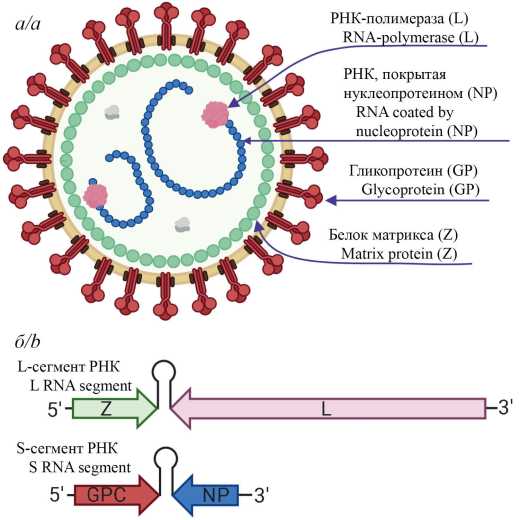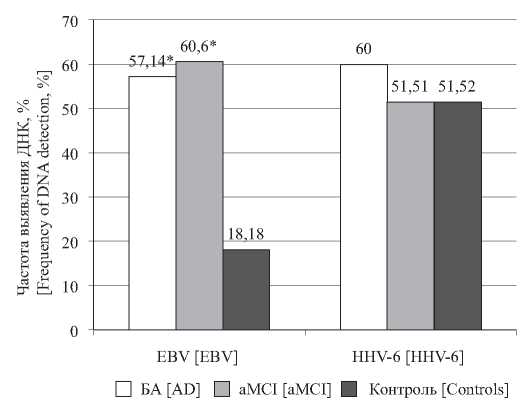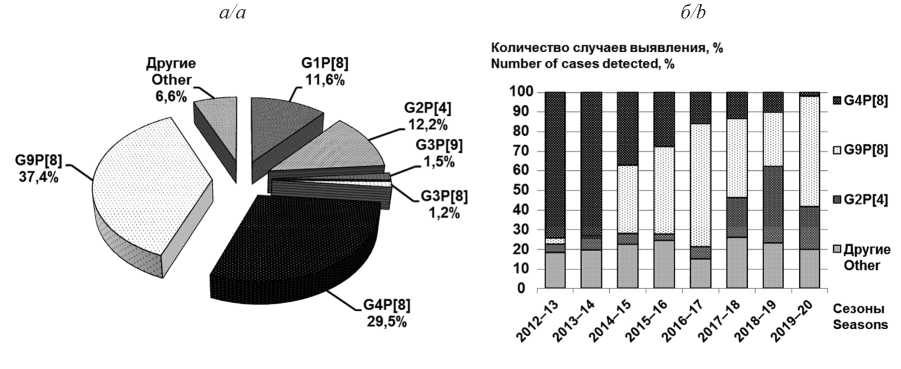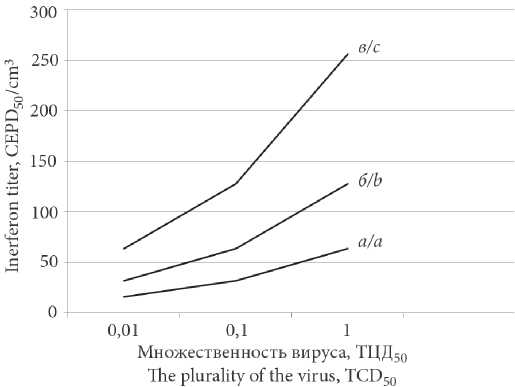Vol 66, No 2 (2021)
- Year: 2021
- Published: 15.05.2021
- Articles: 8
- URL: https://virusjour.crie.ru/jour/issue/view/49
Full Issue
REVIEWS
Review of candidate vaccines for the prevention of Lassa fever
Abstract
The Lassa virus one of the main etiological agent of hemorrhagic fevers in the world: according to WHO estimates, it affects 100,000 to 300,000 people annually, which results in up to 10,000 deaths [1]. Although expansion of Lassa fever caused by this pathogen is mostly limited to the West African countries: Sierra Leone, Liberia, Guinea and Nigeria, imported cases have been historically documented in Europe, the United States of America (USA), Canada, Japan, and Israel [2]. In 2017, WHO included the Lassa virus in the list of priority pathogens in need of accelerated research, development of vaccines, therapeutic agents and diagnostic tools regarding infections they cause [3]. This review describes main technological platforms used for the development of vaccines for the prevention of Lassa fever.
 91-102
91-102


Susceptibility of animal species to experimental SARS-CoV-2 (Coronaviridae: Coronavirinae: Betacoronavirus; Sarbecovirus) infection
Abstract
Due to the new coronavirus infection pandemic, the global scientific community has been forced to change the direction of the most research, focusing on vaccine development as well as the search for new antiviral drugs to treat COVID-19. The choice of experimental models, timeframe and approaches for evaluating drugs and vaccines under development is crucial for the development of effective measures to prevent and control this disease.
The purpose of this review was to summarize the relevant data concerning the susceptibility of laboratory animals to SARS-CoV-2. This paper describes the most virus-susceptible animal species that can be used to reproduce coronavirus infection, stressing the main advantages and disadvantages of each of them.
According to the latest data, small rodents (Rodentia) and non-human primates (Strepsirrhini) are commonly used in the scientific community to model coronavirus infection. The viral load in the upper and lower parts of the respiratory system, clinical symptoms of infection (weight loss, body temperature and general health status), pathomorphological picture in target organs and the production of antibodies after infection are considered to the main markers of pathology. Despite the vast amount of data, none of the described models of SARS-CoV-2 infection may be considered a gold standard, since they do not reproduce all spectrum of morphological and pathogenetic mechanisms of infection, and do not fully reflect the clinical picture observed in patients in human population.
Based on the analyzed literature data, we suppose that Syrian hamster (Mesocricetus auratus) and mice (Muridae) expressing the angiotensin converting enzyme receptor 2 (ACE2) are the most suitable animal species for their use in experiments with SARS-CoV-2 infection. The development of neutralizing antibodies makes it possible to evaluate the efficacy of vaccines, while the course and severity of symptoms infection makes the use of mice and hamsters especially popular for screening pharmacological substances with antiviral mechanism of action, when their administration can prevent or slow the disease progression.
 103-111
103-111


Bats of the subtropical climate zone of the Krasnodar Territory of Russia as a possible reservoir of zoonotic viral infections
Abstract
Emerging and reemerging infections pose a grave global health threat. The emergence of the SARS-CoV-2 virus and the resulting COVID-19 pandemic have demonstrated the importance of studying of zoonotic viruses directly in natural foci. For SARS-like coronaviruses, as well as for many other zoonotic pathogens (including hemorrhagic fevers and rabies agents), the main reservoir are horseshoe bats (Rhinolophus spp.), which are widely distributed in Eurasia and Africa. Their range also covers the southern regions of Russia, including the North Caucasus and Crimea. Large colonies of these animals are located on the territory of Sochi National Park (SNP; subtropical zone of Krasnodar Territory, Greater Sochi region, North Caucasus). In total, according to long-term observations, up to 23 species of bats were registered here, including the great (Rh. ferrumequinum), the lesser (Rh. hipposideros), and the Mediterranean (Rh. euryale) horseshoe bats.
This review provides information on zoonotic viruses associated with species of bats distributed in the subtropical zone of Krasnodar Territory of Russia, and analyzes their possible role as a natural reservoir of emerging and reemerging infections. Studying the circulation of zoonotic viruses in bats is an important element of monitoring viral populations in natural foci.
 112-122
112-122


ORIGINAL RESEARCH
In vitro activity of human recombinant alpha-2b interferon against SARS-CoV-2 virus
Abstract
Introduction. The pandemic spread of a new coronavirus infection, COVID-19, has caused a global emergency and attracted the attention of public health professionals and the population of all countries. A significant increase in the number of new cases of SARS-CoV-2 infection demonstrates the urgency of finding drugs effective against this pathogen.
The aim of this work was to evaluate the in vitro antiviral efficacy of human recombinant alpha-2b interferon (IFN-α2b) against SARS-CoV-2 virus.
Material and methods. The experiments had been carried out on Vero Cl008, the continuous line of African green monkey (Chlorocebus sabaeus) kidney cells. The effectiveness of the drugs was assessed by the suppression of viral reproduction in vitro. The biological activity was determined using titration of a virus-containing suspension in a Vero Cl008 cell culture by the formation of negative colonies.
Results. The antiviral efficacy of the IFN-α2b-based medications, which have a high safety profile and proven efficacy in the prevention and treatment of influenza and acute respiratory viral infections (ARVI), has been studied against the new pandemic SARS-CoV-2 virus in vitro experiments in Vero C1008 cell culture. IFN-α2b effectively inhibits the reproduction of the virus when applied both 24 hrs before and 2 hrs after infection. In the IFN-α2b concentration range 102–106 IU/ml a complete suppression of the reproduction of the SARS-CoV-2 virus had been demonstrated.
Discussion. IFN-α2b demonstrated in vitro high antiviral activity against SARS-CoV-2. In addition, the substance has a high chemotherapeutic index (>1000).
Conclusion. Medications for intranasal use based on IFN-α2b have high antiviral activity and are promising drugs for in vivo study in terms of prevention and treatment of COVID-19.
 123-128
123-128


Herpesvirus infections and immunological disturbances in patients with different stages of Alzheimer’s disease
Abstract
Introduction. Alzheimer’s disease (AD) is a multifactorial disease that leads to a progressive memory loss, visualspatial impairments, emotional and personality changes. As its earliest pre-dementia clinical stage, amnestic mild cognitive impairment syndrome (aMCI) is currently considered. Neuroinflammation plays a role in the development and progression of aMCI and the initial stage of AD, which can be supported by immunological disorders of a systemic character. Study of factors, including infections, influencing immune disorders and systemic inflammatory response in patients with aMCI, is of great importance.
The aim of this study was to obtain new data on the possible role of herpesvirus infections in the development and progression of aMCI.
Material and methods. 100 patients with aMCI diagnosis, 45 patients with AD, 40 people from the control group were enrolled into the study. The frequency of DNA detection of herpesviruses (Epstein–Barr virus (EBV), human herpesviruses (HHV) type 6 and 7, cytomegalovirus (CMV)), the levels of viral load and the serological markers of herpesvirus infections (IgG to HHV-1, IgG to CMV) were determined. Immunological studies included an assessment of the level of the main pro-inflammatory and anti-inflammatory cytokines, and indicators of humoral and cellular immunity.
Results. The study found an increased detection rate of EBV in saliva and a higher level of EBV DNA in saliva in aMCI and AD than in the control group. A relationship between the presence of active EBV infection and changes in immunological parameters in patients with aMCI were found. It was also discovered that the level of IgG antibodies to CMV is associated with the stage of AD.
Discussion. The results indicate a possible role of EBV- and CMV-induced infections in the development of immunological changes which are typical for mild cognitive impairment and in the progression of AD.
Conclusion. The obtained data can be important for prognostic methods addressing AD development, including its pre-dementia stage, and for new approaches to individualized treatment and prevention.
 129-139
129-139


Molecular monitoring of the rotavirus (Reoviridae: Sedoreovirinae: Rotavirus: Rotavirus A) strains circulating in Nizhny Novgorod (2012–2020): detection of the strains with the new genetic features
Abstract
Introduction. The pentavalent rotavirus vaccine has been registered in Russia, however, the vaccination coverage remains low, and an annual increase in the incidence of rotavirus infection is unavoidable. In this regard, molecular monitoring of rotaviruses in order to search for new variants possessing epidemic potential is an urgent task.
Material and methods. PCR genotyping and VP4 and VP7 genes sequencing were used to characterize rotaviruses circulating in Nizhny Novgorod in 2012–2020. The phylogenetic analysis of the strains was carried out using the BEAST software package.
Results. The spectrum included 17 genotypes with predominance of G9P[8] (37,4%). Detected in this study genotypes G1P[4], G1P[9], G2P[8], G4P[4], G4P[6], G8P[8], and G9P[4] were not previously identified in Nizhny Novgorod. The circulation of DS-1-like strains possessing genotypes G1P[8], G3P[8], G8P[8], or G9P[8] and a short RNA pattern had been shown. Rotaviruses of the common genotypes were genetically heterogeneous and belonged to different phylogenetic lineages and/or sublineages (P[4]-IV-a; P[4]-IV-b; P[8]-3.1; P[8]-3.3; P[8]-3.4 and P[8]-3.6; G1-I; G1-II; G2-IVa-1; G2-IVa-3; G3-1; G3-3; G4-I-c; G9-III; G9-VI).
Discussion. These results extend the available data on the genotypic structure of rotavirus populations in Russia and show the genetic diversity of viral strains. G3P[8] DS-1-like viruses were representatives of the G3-1 lineage, new for the territory of Russia, and had the largest number of amino acid substitutions in the VP7 antigenic epitopes.
Conclusion. The emergence and spread of strains with new genetic features may allow rotavirus to overcome the immunological pressure formed by natural and vaccine-induced immunity, and maintain or increase the incidence of rotavirus infection.
 140-151
140-151


Reactivation of Epstein–Barr virus (Herpesviridae: Lymphocryptovirus, HHV-4) infection during COVID-19: epidemiological features
Abstract
Introduction. Immunodeficiency underlying the development of severe forms of new coronavirus infection may be the result of mixed infection with SARS-CoV-2 and other pathogens, including Epstein–Barr virus (EBV).
The aim is to study the prevalence and epidemiological features of co-infection with SARS-CoV-2 and EBV.
Material and methods. A cross-sectional randomized study was conducted in Moscow region from March to May 2020. Two groups were examined for EBV-markers: hospital patients (n = 95) treated for SARS-CoV-2 infection and blood donors (n = 92).
Results. With equal EBV prevalence the detection of active infection markers in donors (10.9%) was noticeably lower than in SARS-CoV-2 patients (80%). Significant differences in this indicator were also found when patients from subgroups with interstitial pneumonia with the presence (96.6%) and absence (97.2%) of SARS-CoV-2 in the nasopharyngeal smear were compared with the subgroup of patients with mild COVID-19 (43.3%). The average IgG VCA and IgG EBNA positivity coefficients in donor group were higher than in patient group (p < 0.05). Patients with active EBV infection markers were significantly more likely to have pneumonia, exceeding the reference values of ALT and the relative number of monocytes (odds ratio – 23.6; 3.5; 9.7, respectively).
Discussion. The present study examined the incidence and analyzed epidemiological features of active EBV infection in patients with COVID-19.
Conclusion. A significantly higher rate of detection of active EBV infection markers in hospital patients indicates a combined participation SARS-CoV-2 and EBV in the development of interstitial pneumonia. Low levels of specific IgG EBV serve as predictors of EBV reactivation. Exceeding the reference values of ALT and the relative number of monocytes in patients should serve as a reason for examination for active EBV infection markers.
 152-161
152-161


TO VIROLOGIST’S AID
Interferonogenic activity of the strain BH-3 duck hepatitis virus type I (Picornaviridae: Avihepatovirus: Avihepatovirus A)
Abstract
Introduction. Duck viral hepatitis type I (DVH-I) is a poorly studied contagious disease caused by RNA-containing duck (Anatinae) hepatitis virus type I (Picornaviridae: Avihepatovirus: Avihepatovirus A). This infection is widespread in many countries, including Russia, and causes significant damage to industrial duck breeding. The study of interferonogenic activity of its etiologic agent strains is of great importance in solving the problem of developing effective means to control the disease.
Material and methods. Strain BH-3 of duck hepatitis virus type I isolated from the liver of sick ducklings was used in the study. The strain was adapted to developing 10–12 day old duck embryos, to the cell culture of chicken and duck fibroblasts and deposited in the State Collection of Viruses of the D.I. Ivanovsky Institute of Virology of FSBI «National Research Centre for Epidemiology and Microbiology named after the honorary academician N.F. Gamaleya» of the Ministry of Health of Russia. Experiments were performed using the standard tissue culture method.
Results and discussion. Data on the ability of the viral strain BH-3 to induce interferon (IFN) and its sensitivity to the action of exogenous interferon in the culture of duck fibroblasts are presented. It has been shown that the interferonogenic activity of this strain of the hepatitis virus is in direct proportion to the multiplicity of infection. The maximum induction of IFN (1 : 256 CEPD50) was observed at a dose of 1.0 TCD50/cell in 72–96 hrs after inoculation of the cell culture. Exogenous IFN at a dose of 1 : 128 completely suppressed the cytopathic effect and death of duck embryos infected with hepatitis virus at a dose of 100 TCD50/cell.
Conclusion. The data obtained allow us to state that the vaccine strain BH-3 of duck hepatitis virus type I has a pronounced interferonogenic activity and sensitivity to the action of exogenous IFN. This may have implications for the development of effective therapeutic agents against DVH-I.
 162-166
162-166















